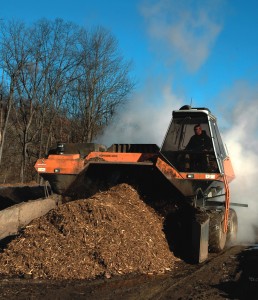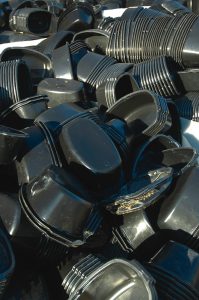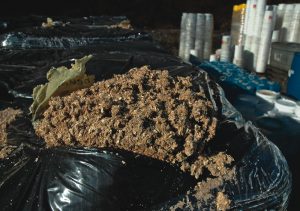Facility shifts from focus primarily on horse manure to a variety of commercial and industrial vegetative food waste streams. Next is the possibility of postconsumer feedstocks.
Dan Sullivan
BioCycle February 2012, Vol. 53, No. 2, p. 26
In 2005, Jay and his wife, Jill, incorporated Ag Choice as a full-fledged business and soon started taking in food waste from four ShopRite grocery stores, providing them with sealed 15 cubic yard (cy) lockable roll-off containers and utilizing their own trucks for hauling. Feedstock sources now include six ShopRites, two Costcos, the New Jersey Food Bank, a wholesale fruit and vegetable distributor, the occasional tractor trailer load full of spoiled bananas or sweet potatoes, and industrial organics from manufacturers arriving in packaging or containers ranging from individual packets to 55-gallon drums.
Today both of Jay Fischer’s parents have passed away and the sawmill is closed, but business at Ag Choice continues to grow. More employees have been added and the quantity of food waste coming in has been increasing. “And we’ve been able to sell every ounce of compost and topsoil that we make,” says Jay Fischer. Clients for bulk and bagged compost include garden centers, landscapers, homeowners, townships and schools districts (for application on athletic fields).
Situated near the heart of food-flavoring producers, Ag Choice takes in a variety of interesting and diverse feedstocks from that industry. On the clear and crisp December day BioCycle visited the facility, a crimson mountain of carbon-rich herb bark towering 10-feet high was waiting to be incorporated into windrows along with wet, nitrogen-rich food scraps. “We have some of the largest flavoring manufacturers in the world, doing various extractions from leaves, herbs, nuts, twigs and all kinds of things you wouldn’t even imagine,” says Fischer. “We collect the fleshy part that’s left over from that extraction process as well as various types of paper filters, and we use those as feedstocks in our composting operation.” “Flavor” feedstocks routinely include herb and cassia (cinnamon) bark, coffee beans, cocoa nibs, various syrups and purees and soy by-products. These are added to ground wood waste, municipal leaves, corn silage, dairy and horse manure (that typically includes a high percentage of carbon-rich bedding materials) and preconsumer food waste. Ag Choice also recycles a significant amount of bakery waste directly into animal feed (see below).
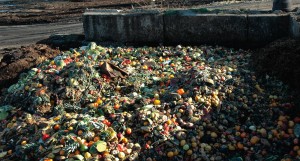
Food waste, primarily from grocery stores and food processors, has become a growing part of the feedstock stream.
For most of the grocery and food service outlets it serves, Ag Choice continues to provide bins and collects with its own trucks. “We also allow other haulers to bring materials,” says Jill Fischer, adding that the company’s tipping fee ranges from between 35 to 50 percent less than those charged by area landfills. Tipping fees can vary based on several factors including the type of material being processed as well as the amount of depackaging necessary.
Facility Permitting
New Jersey’s composting rules do not explicitly include food waste. For example, a facility processing more than 10,000 cubic yards (cy) annually of materials normally requires a Class C permit from the New Jersey Department of Environmental Protection (NJDEP). This permit does not expressly include permission to handle food waste (however current recycling laws allow for it under Class C if certain additional requirements are met.). “The Class C permit fees and the process are extraordinarily expensive and time consuming,” says Jay Fischer. “A decade ago, the combined fees for a Class C permit were around $30,000 for the first year and $16,000 thereafter. It required all kinds of permanent monitoring wells, and no outdoor windrow facilities were allowed — it had to be in a building. We’re trying to prove that you can obtain the same results outdoors utilizing windrow covers.”
Ag Choice, currently the only commercial food waste and livestock manure composter in New Jersey, has been operating under a Class C Research, Development & Demonstration (RD&D) permit issued by the NJDEP. It is permitted to receive 20,500 cy/year of incoming materials. “Right now we are trying to expand our RD&D to be able to collect postconsumer food waste in addition to the preconsumer food waste we’re currently collecting,” says Fischer.
The staff has expanded, from four full-time employees (including the Fishers) when BioCycle visited the facility in 2007 to a staff of seven. “It’s really just taken on a life of its own,” says Fischer. “We’re the only business of its kind in the state, so there’s a tremendous need,” adds Jill Fischer. “Not only are we the only permitted food waste composter in the state,” notes Jay, “there is a need for good quality finished product, both topsoil and compost-wise.”
Upgrading And Innovating
Ag Choice recently purchased a Komptech Topturn 4000 turner from an equipment dealer in Denmark with only about 900 hours logged on the machine for about 20 percent of retail. “We started out with a Midwest BioSystems pull-type turner,” he says. “We outgrew that and upgraded to the Komptech straddle type turner. We’ve been able to double our capacity on the same footprint.” The original turner was sold to a nearby organic farmer.
The facility has two clay composting pads (1.5 acres and 3 acres). With the new turner, the windrows are now larger — 12-feet wide by about 7 feet tall (and 125-feet long) as opposed to 10-feet wide by 5-feet high. The piles have slightly outgrown their covers (new ones are in the next budget cycle). “When we first started using the new turner, we had two windrows side by side built with the exact same recipe and neither would come up to temperature,” recalls Fischer. “I knew the C: N ratio and moisture content were right, so we took wood chips and added them to one windrow and within three days we were up to 130°F and the other windrow was still at 80°F. What a night and day difference.”
The issue was porosity. “With the smaller windrows and the smaller turner, porosity wasn’t as big an issue; now with these bigger windrows it is a major factor,” he explains. A freak winter storm had left literally tons of woody debris — most still bearing leaves — scattered around the region. “One of the towns had someone come in and grind it, and we’re hauling away all the material,” says Fischer. “The pieces of wood are much bigger and we pull out [the overs] and can recycle them again and again … It’s going to take quite a few years to run out of what we have.”
The larger windrows also do not require turning as frequently. “When you turn that big of a windrow, you need a couple of extra days to get the cores back up to temperature,” he adds. The current turning schedule is once every three days for the first two weeks, twice every five days in weeks three and four and once a week for an additional six to eight weeks until the compost is mature. Temperature and moisture are monitored regularly and adjustments made to the turning schedule when necessary.
Change Of Focus
Ag Choice continues to evolve, with its focus changing from agricultural waste to more food waste recycling. “It’s been a twofold change — part of it’s been the economics and the other part of it is regulations,” explains Fischer. “It started off that new nutrient management laws were going to have some teeth and help ensure compliance with storm water runoff related to livestock waste here in New Jersey.” But the law got watered down, he says, and enforcement — and thus compliance — has been an issue. (Farms have until March 2012 to implement best management practices as part of their required farm plans, according to Rutgers Cooperative Extension.)
Without penalties for stockpiling manure, or for other questionable management practices, the agricultural component of Ag Choice’s business took a big hit. “We’ve actually lost about half of our livestock waste customers that were utilizing us for manure removal,” says Fischer. “Here in Sussex County, you can’t go 200 feet and you’re running into some sort of creek, stream, lake or pond, so the environmental ramifications are huge. Manure has been identified as one of the largest nonpoint water pollutants in New Jersey.”
Despite the decline on the agricultural side, Fischer says, the food waste side continues to grow. And the economics are definitely better. “We used to leave a [20-yard roll-off] container onsite for a horse farm to fill as they needed it,” explains Jill Fischer. “The larger facilities might fill it once a week, but for other facilities it might take a month to fill that same container. We’d maybe get a few hundred dollars. But we can leave that same container onsite at a food manufacturing facility and make twice as much money … and pull it three times as frequently.”
With Ag Choice’s new direction comes other decisions on balancing environmental and economic concerns, such as whether to accept compostable plastics — which the National Organic Program has currently banned from compost destined for USDA Certified Organic farms. “It hasn’t been an issue for us in the past, but if we’re going to be taking in postconsumer food waste, and if the organic organizations aren’t going to recognize compostable plastics positively, then we’ll lose our organic status,” Jay Fischer says without hesitation. “It’s simple economics. We want to do the right thing, and I believe in organic production, but at the same time my sales to organic farms for compost and topsoil are minimal. Compare that to being able to take in an extra 20 to 30 tons a week of food waste to compost. Which one am I going turn away?”
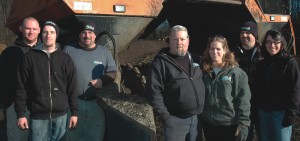
Ag Choice staff (from left): Matt Hillsdon, Russ Covert, Brian Kardos, Jay Fischer, Jill Fischer, Eric Rossi and Kelly Rossi.
Materials Handling
Ag Choice’s office and receiving area for most of the feedstocks requiring depackaging sit on the old sawmill site a couple of miles away from the 10-acre composting facility, which is on leased land. “We’re in the process of trying to purchase our own property somewhere in the same vicinity in Sussex County and actually being able to double our production from the 20,000 cubic yards a year that we’re permitted for now to at least 40,000 or 50,000 cy,” says Fischer, adding that this would include postconsumer food waste.
Originally permitted to compost only fruit, vegetable, floral and bread waste, Fischer expresses confidence that NJDEP will continue to allow him to innovate. “We’ve developed an excellent relationship with our DEP, and it’s based on trust. They know that when I say I want to do something at the farm, we have science behind what we’re looking to do and that we follow through and do it — and they come and check us out once a month,” he says, adding with a smile, “whether we want them to or not.” Building that trust has been an evolution that has served all parties. “When we first said we wanted to compost food waste, you would have thought I’d said we wanted to compost nuclear waste — everybody was in a panic,” he recalls.
Over time and as new knowledge has been gained, NJDEP has responded by being more flexible, he adds. “There’s a law on the books that says you can’t stockpile leaves … One of the things with handling food waste is you’ve got to have that available carbon to blend with it to keep your odors under control … By allowing us to stockpile the leaves, it’s enabled me to take in the food waste and blend it as soon as it comes in and we have never had an odor issue. That part of the RD&D has allowed us to double to 20,500 cubic yards to see if we can handle the increase in food waste.”
A three-and-a-half year extension to the original three-year RD&D permit is up at the end of 2012. According to Ag Choice’s NJDEP permit writer Joseph Staab, whether the facility will need to apply for a Class C permit at the end of that time is undetermined. An extension on the RD&D permit would require a demonstration of new innovative research and technology, he says. “They’re talking about taking in all types of food waste — including plate waste and other postconsumer waste — so that might be something we would consider under a new RD&D. It’s not going to go on too much longer, though. But we are getting valuable research data, and because they are getting bigger we’re getting different data as well than when they were smaller scale. It could be another couple of years at most, or we could require full-blown [Class C] approval at the end of this year.”
Staab says he last visited the facility in December, when he learned of Ag Choice’s shifted focus, and what prompted it. He says one of the problems, of which NJDEP was only recently made aware, is that some nurseries are receiving raw horse manure from the farms for free or at nominal cost and mixing it with inferior soils to be sold as a soil product. During his visit, Staab says he and Fischer discussed the practice as a loophole that needed closing. “That is not the way to deal with manure; it’s not being composted, and there are lots of pathogens remaining in the soil/manure blend,” acknowledges Staab. The NJDEP is currently in talks with the state Department of Agriculture to determine what measures can be taken to address the issue, says Stabb, adding that Ag Choice is the only place in the state currently sanctioned to compost horse manure and that very little is being collected and making it to the site.
Lessons learned from working with Ag Choice? “They’ve demonstrated that food waste and horse manure can be handled outside in an environmentally effective way, so we might not require another operator to compost indoors and — if conducted outside — possibly waive the impervious pad requirement under the current regulation,” adds Staab. “It might have made the process a bit easier to get a solid waste approval.”
Still, Staab wonders if there will be more potential operators coming forward. “Obtaining a Class C General Approval with all the associated fees is significant,” he explains. “In addition, they would have to have a really good location due to odor and water issues.” Current fees are: $11,582, initial permit fee; $7,928, annual registration fee; $9,130, annual enforcement fee; $4,826, five-year permit renewal fee. “On an annual basis for the first 5 years of operations it averages $19,374.40/year,” says Staab. “After the first five years, it averages $18,023 per year. These fees include taking animal manure and food waste.” There is no difference in Class C fees if one is taking food waste and/or manure (versus only taking yard trimmings, for example), explains Staab, but site design and engineering costs are greater in order to be allowed to process them. “You have to be as big as Ag Choice is now, handling at least 15,000 cubic yards of material a year, in order to be able to pay all the fees and costs associated with running the operation,” says Staab. “It’s about economies of scale; you can’t be too small.”



